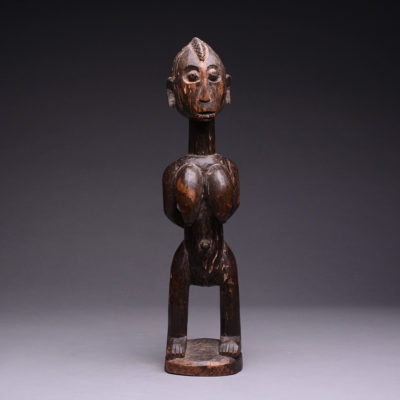
| SKU | PF.3630 (LSO) |
|---|---|
| Circa | 20 th Century AD |
| Dimensions | 17″ (43.2cm) high x 4″ (10.2cm) wide |
| Medium | Wood |
| Origin | Central Mali |
| Gallery Location | USA |
This charming figure of a standing woman holding a child on her back was made by the Bambara/Bamana of Mali, and poses something of a quandary. The rendering is simple yet highly effective, especially when combined with the delightful glossy use patination. The figure stands full-square, with legs apart and head upraised. The legs and arms are roughly the right length for the body, but are curved in a decidedly unanatomical manner. The torso is long, with grooves at the corners of the thighs and arms to lend a sectorial impression. The breasts are studendously oversized, and curve downwards with the weight which is caused – one presumes – from breastfeeding the small child who is being held against her lower back. The neck is very long and columnar, supporting a deep head with a placid, impassive expression. The figure is topped with crested hair and the aforementioned glossy finish.
The Bambara/Bamana are one of the largest groups in Mali (about 2.5 million) and lives in a savannah grassland area that contrasts strongly with the Dogon heartland. Their linguistic heritage indicates that they are part of the Mande group, although their origins go back perhaps as far as 1500 BC in the present-day Sahara. They gave rise to the Bozo, who founded Djenne in an area subsequently overrun by the Soninke Mande (<1100 AD). Their last empire dissolved in the 1600s, and many Mande speakers spread out along the Nigeria River Basin. The Bamana empire arose from these remnant populations in around 1740. The height of its imperial strength was reached in the 1780s under the rule of Ngolo Diarra, who expanded their territory considerably.
They have a very complex caste-based social system, while age, sex and occupation groups are also classed to reflect their social importance. This complex structure is echoed in the systematics of indigenous art traditions. There are four main mask forms, related to the n’tomo, Komo, Nama and Kore societies. Sculptures include Guandousou, Guaitigi and Guanyenni figures, that are used to promote fertility and social balance, while heavily encrusted zoomorphic Boli figures serve an apotropaic function. Everyday items include iron staffs, wooden puppets and equestrian figures; their sexually-constructed anthropomorphic door locks are especially well-known.
Figures such as this are blatantly connected with fertility, maternity and sexuality. However there is little reference to such pieces in the Bamana repertoire. It is therefore possible to be one of two things. The first is a totally secular, personal piece that is designed to encourage a successful pregnancy. The other is that it is a Guanyenni sculpture, one of the five female attendants that are positioned around the Guandousou and Guantigui sculptures, designed to assist the king/queen figures in their encouragement of fertility. It so, it is an unusually small example, but the superbly patinated surface give it an impact far beyond its inches.
This is a beautiful piece of African art.
- (PF.3630 (LSO))

Sign-up to receive the latest Wedding Estates news and promotions!

